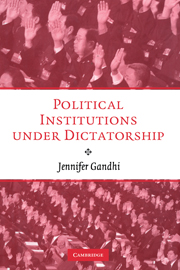Book contents
- Frontmatter
- Contents
- List of Tables and Figures
- Acknowledgments
- Introduction
- 1 The World of Dictatorial Institutions
- 2 Three Illustrative Cases
- 3 Use of Institutions to Co-opt
- 4 Institutions and Policies under Dictatorship
- 5 Institutions and Outcomes under Dictatorship
- 6 Institutions and the Survival of Dictators
- 7 Conclusion
- 8 Codebook of Variables
- Bibliography
- Author Index
- Subject Index
6 - Institutions and the Survival of Dictators
Published online by Cambridge University Press: 25 July 2009
- Frontmatter
- Contents
- List of Tables and Figures
- Acknowledgments
- Introduction
- 1 The World of Dictatorial Institutions
- 2 Three Illustrative Cases
- 3 Use of Institutions to Co-opt
- 4 Institutions and Policies under Dictatorship
- 5 Institutions and Outcomes under Dictatorship
- 6 Institutions and the Survival of Dictators
- 7 Conclusion
- 8 Codebook of Variables
- Bibliography
- Author Index
- Subject Index
Summary
INTRODUCTION
Some dictators rule so long that they are feared even after their deaths, whereas others fall almost immediately. Sobhuza II reigned over Swaziland sixty-two years; Haile Selassie of Ethiopia ruled for forty-seven years. Even those without royal blood can hold onto power for ages: Kim Il Sung died in 1994 after forty-seven years in power. Even in death he remains the Eternal Leader. Yet for every Kim Il Sung, there is a Léon Cantave, the first of many who tried to take power in 1957 in Haiti: he lasted five days. Why do some dictators survive for decades, whereas others fall soon after taking power?
The force of tradition or legitimacy from religious or other sources may play a role in the survival of some rulers, particularly monarchs. But, then again, it was not enough to save Libya's King Idriss, Egypt's King Fuad II, or Iraq's King Faisal II from being deposed in military coups. Similarly, charismatic or personalistic leadership is frequently evoked to explain the maintenance of power in sub-Saharan Africa (Bratton and Van de Walle 1997; Jackson and Rosberg 1982, 1984). Yet, along with Southeast Asia and the Middle East and North Africa, this region has one of the highest turnover rates of dictatorial rulers.
Alternatively, the long tenure of some dictators is attributed to their overwhelming monopoly of force.
- Type
- Chapter
- Information
- Political Institutions under Dictatorship , pp. 163 - 179Publisher: Cambridge University PressPrint publication year: 2008
- 1
- Cited by

